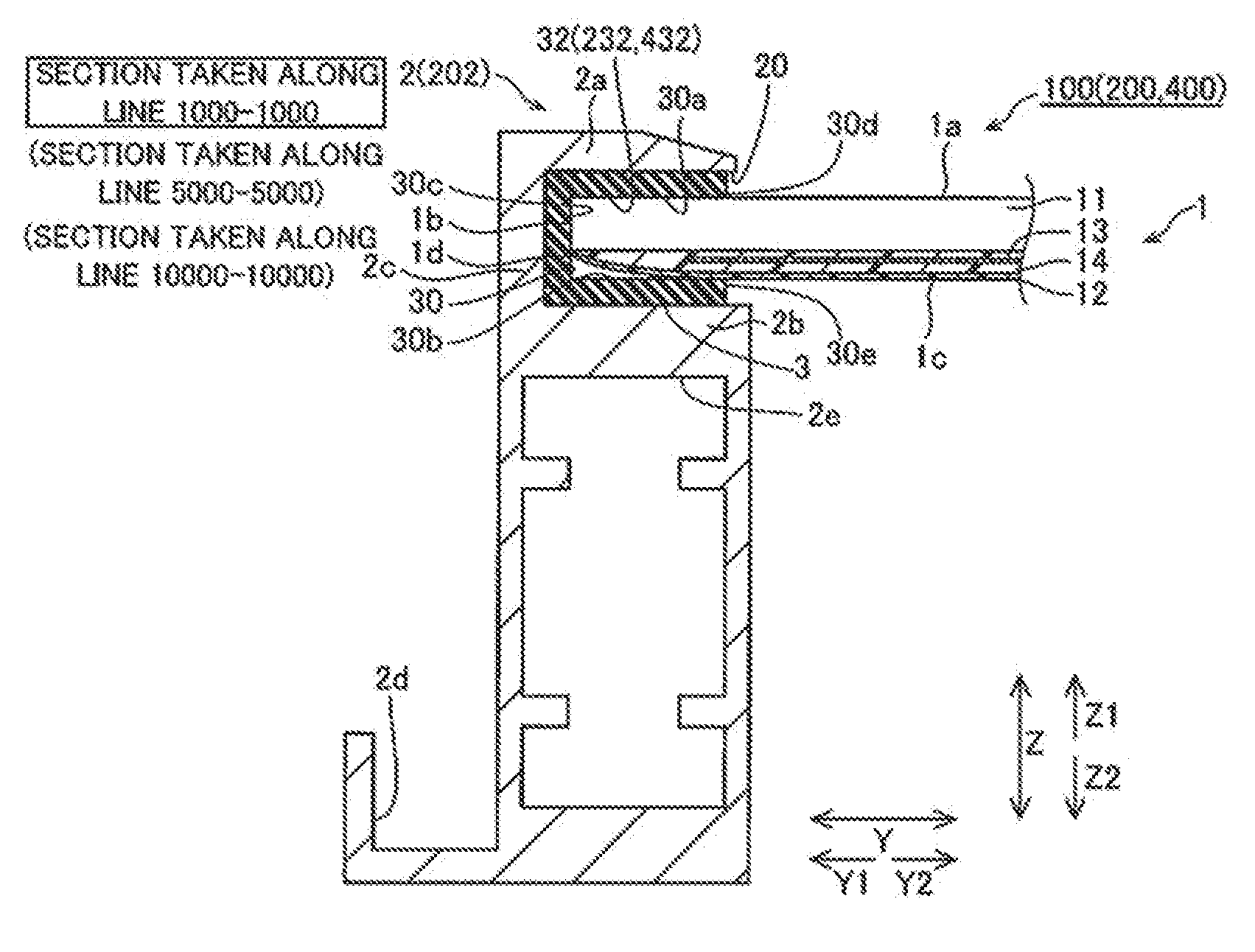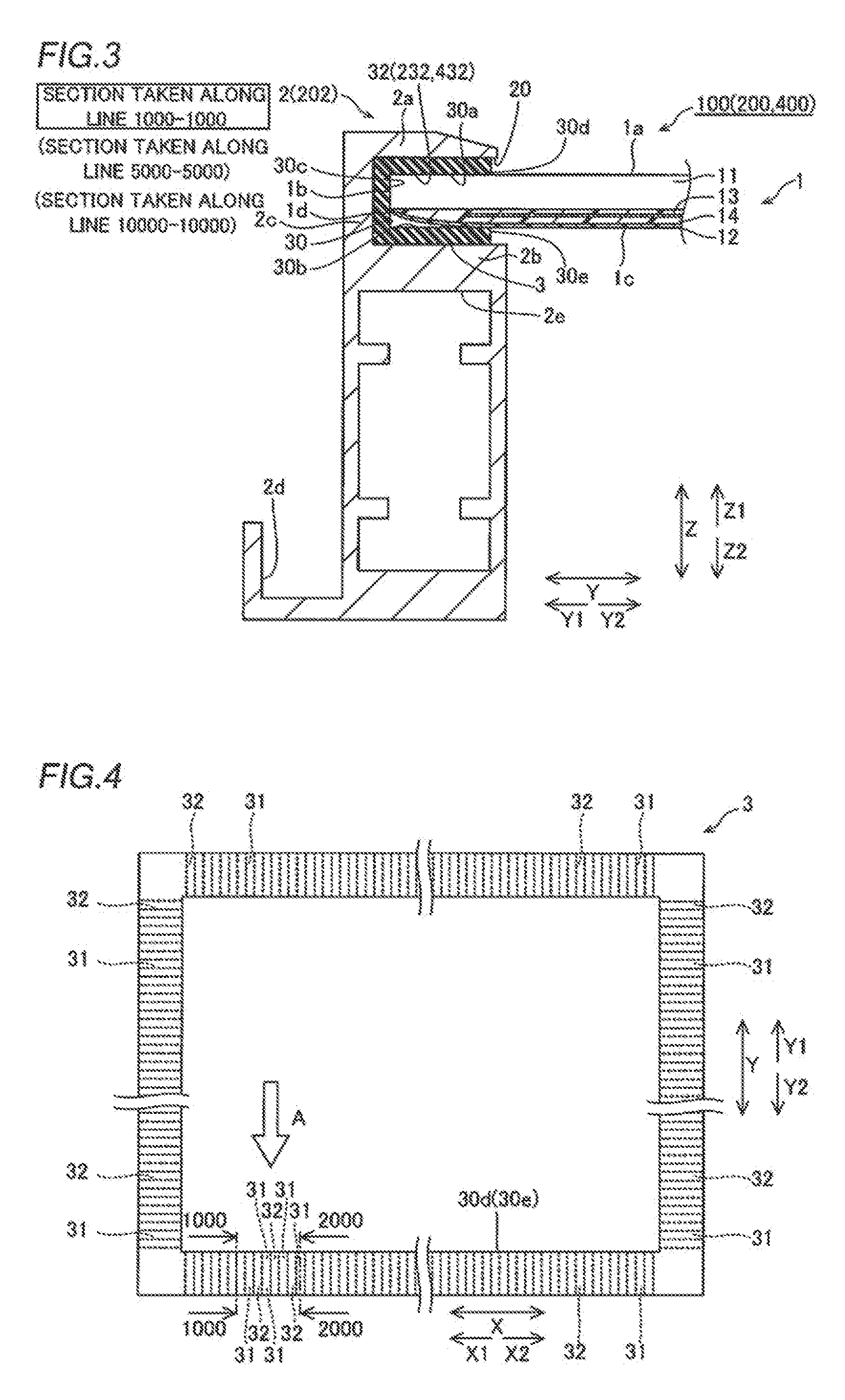Solar cell module
a solar cell module and solar cell technology, applied in the field of solar cell modules, can solve the problems of insufficient mechanical strength of the side of the frame (frame body) located on the lower side of the solar cell module when it is obliquely placed, and difficulty in discharge of water
- Summary
- Abstract
- Description
- Claims
- Application Information
AI Technical Summary
Benefits of technology
Problems solved by technology
Method used
Image
Examples
first embodiment
[0062]As shown in FIGS. 1 and 2, a solar cell module 100 according to a first embodiment is constituted by a solar cell panel 1, a frame body 2 made of metal such as aluminum to support the solar cell panel 1, and a gasket 3 (see FIG. 1) made of rubber or the like arranged between the solar cell panel 1 and the frame body 2. In plan view, the solar cell panel 1 has a substantially rectangular shape.
[0063]As shown in FIG. 3, the solar cell panel 1 is constituted by a water-resistant upper surface-side cover 11 made of glass, a weather-resistant lower surface-side cover 12 made of a resin film of polyethylene terephthalate (PET) or the like, a plurality of solar cells 13 arranged between the upper surface-side cover 11 and the lower surface-side cover 12, and a filler 14 provided between the upper surface-side cover 11 (lower surface-side cover 12) and the plurality of solar cells 13. The upper surface-side cover 11 is an example of the “upper surface cover portion” in the present inv...
second embodiment
Modification of Second Embodiment
[0089]Next, a solar cell module 300 according to a modification of the second embodiment of the present invention is described with reference to FIGS. 17 to 20. In this modification of the second embodiment, a gasket 303 is constituted by an upper gasket 340 and a lower gasket 350, dissimilarly to the aforementioned second embodiment in which the gasket 203 is integrally formed.
[0090]As shown in FIGS. 17 and 18, the gasket 303 of the solar cell module 300 according to the modification of the second embodiment is constituted by the upper gasket 340 and the lower gasket 350. This upper gasket 340 is formed with an upper surface portion 341, protrusion portions 342 formed at constant intervals to protrude downward (along arrow Z2) from the upper surface portion 341, and contact portions 343 formed on a side opposite to a side from which a solar cell panel 1 is inserted (see FIGS. 19 and 20), extending downward from the protrusion portions 342. These pro...
third embodiment
Modification of Third Embodiment
[0102]Next, a solar cell module 500 according to a modification of the third embodiment of the present invention is described with reference to FIG. 25. In this modification of the third embodiment, discharge holes 502g are provided in a lower portion 2b of a frame body 502, dissimilarly to the aforementioned third embodiment in which the discharge holes 202f are formed in the side surface portions 2c of the frame body 202.
[0103]As shown in FIG. 25, the discharge holes 502g are formed in the lower portion 2b of the frame body 502 of the solar cell module 500 according to the modification of the third embodiment. The discharge holes 502g are formed to pass through the lower portion 2b of the frame body 502 in a direction Z. Thus, water reaching the discharge holes 502g through grooves 431 and notches 434 of a gasket 403 passes through the discharge holes 502g and hollow portions 2e, and thereafter is discharged to external portions (outer peripheral gr...
PUM
 Login to View More
Login to View More Abstract
Description
Claims
Application Information
 Login to View More
Login to View More - R&D
- Intellectual Property
- Life Sciences
- Materials
- Tech Scout
- Unparalleled Data Quality
- Higher Quality Content
- 60% Fewer Hallucinations
Browse by: Latest US Patents, China's latest patents, Technical Efficacy Thesaurus, Application Domain, Technology Topic, Popular Technical Reports.
© 2025 PatSnap. All rights reserved.Legal|Privacy policy|Modern Slavery Act Transparency Statement|Sitemap|About US| Contact US: help@patsnap.com



